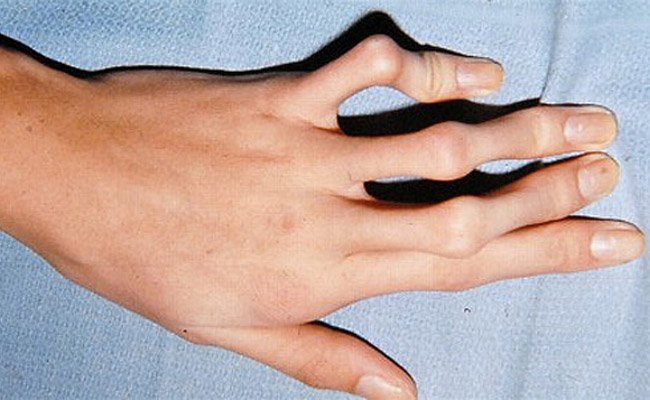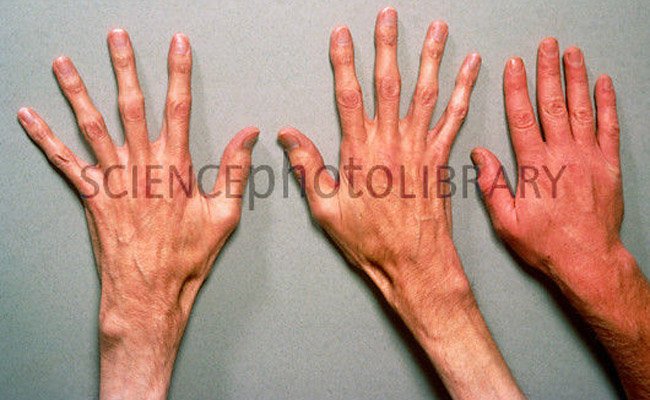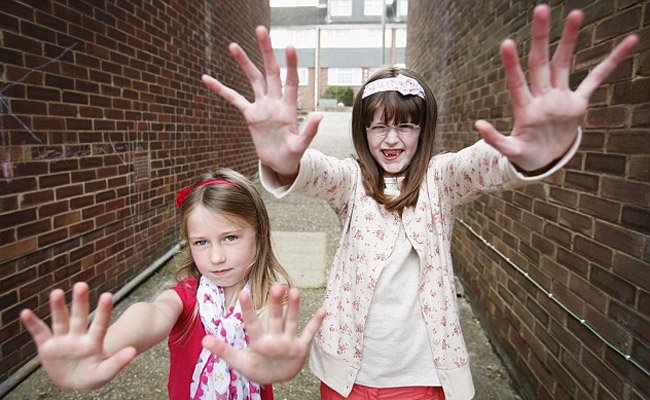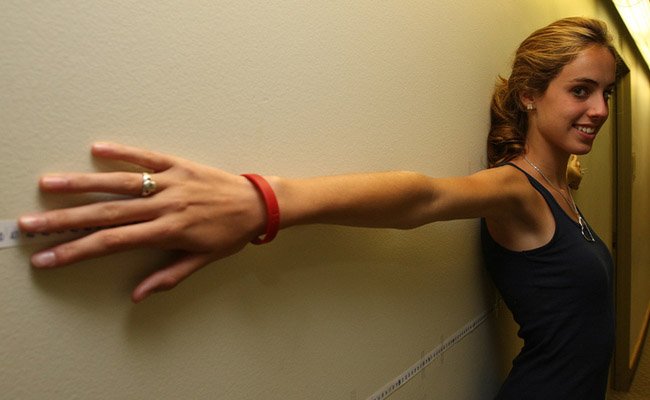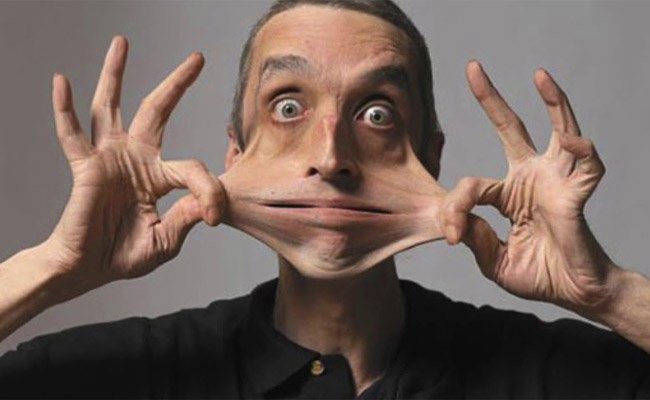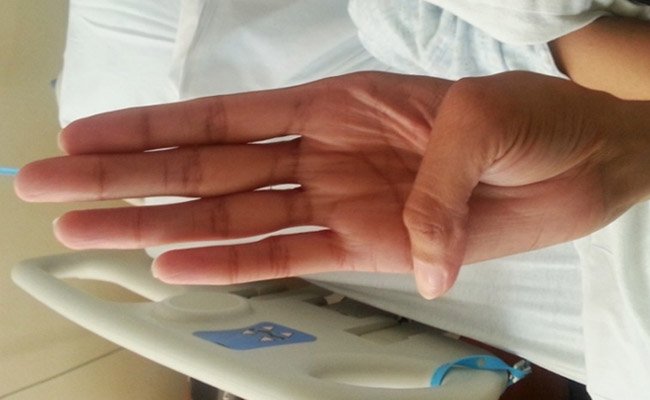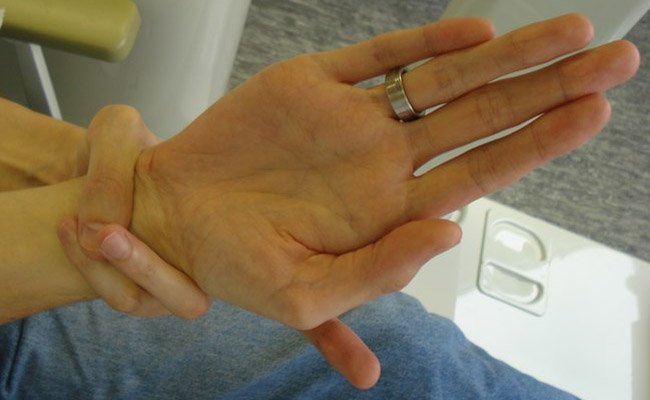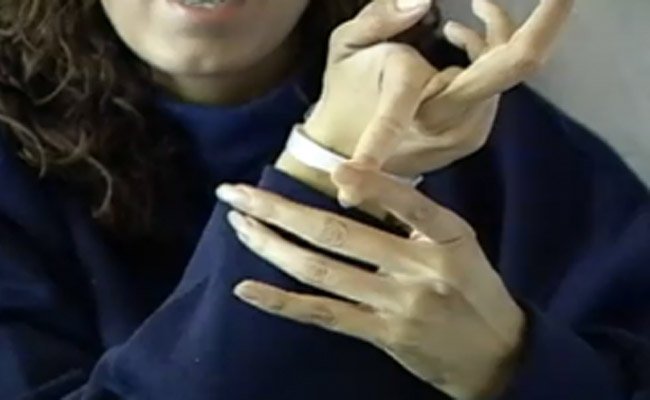
Marfan Syndrome Hand Test: 10 hand signs!
- The Marfan Syndrome Hand Test serves as a quick & costless 'screening tool' for Marfan syndrome -
Marfan syndrome involves a genetic disorder of the connective tissue, typically featured with a physical appearance with 'elongation' of body parts [dolichostenomelia].
The hand in Marfan syndrome can usually be recognized at first glance by the presence of long slender fingers, a.k.a. 'spider fingers'. Also, the combination of the wrist AND thumb sign represents the most significant body sign in Marfan syndrome; however there is a long list of other significant hand signs in Marfan syndrome.
A hand test is presented for Marfan syndrome, featured with 10 hand signs highly significant for MFS (+ as a supplement to the test 8 other hand signs significant for MFS are listed).
A slideshow for the hand in Marfan syndrome is also presented in the bottom-section!
A (validated) screening tool for the hand in Marfan syndrome is presented here based 10 most significant hand signs.
The test covers multiple dimensions of the hand, including: hand shape (4 signs), skin qualities (2 signs) and motorics (4 signs).
Next to the 10 hand signs included in the test, a list featured with 8 other hand signs significant for Marfan syndrome is presented.
NOTICE - The medical literature refers to the phenomenon involving 'extraordinary long fingers' with various related terms, such as: arachnodactyly, dolichodactyly, metacarpal index & skeletal maturity.

IMPORTANT: In order to pass the 'Marfan Syndrome Hand Test' a score of 17 or higher is required for adults (for children: 18 or higher). An early validation study has indicated that more than half of Marfan people (people confirmed by an official diagnosis) are likely to pass the 'Marfan Syndrome Hand Test'; non-Marfan people are unlikely to pass the test; however, a relatively small percentage of people with Loeys-Dietz syndrome & Ehler-Danlos syndrome passes the test as well. Also, even though people who have Beals syndrome also have a Marfanoid appearance, they are unlikely to pass the test due to the typical muscle contractors that result in inflexible hands).
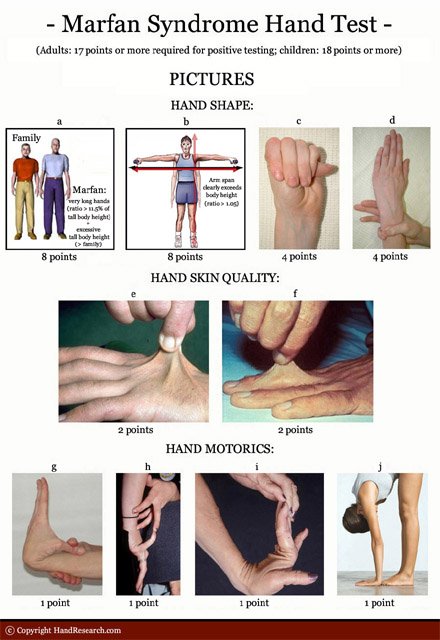
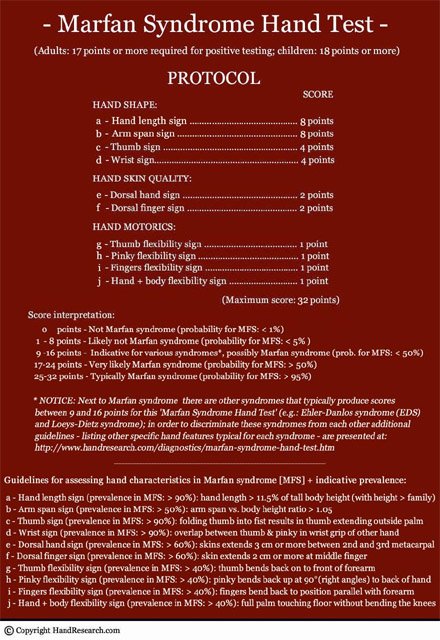
This test has been validated with self-reports by 20 persons who have Marfan syndrome; 16 Marfan persons have passed the test, 3 Marfan persons scored in the 'borderline' category (which is indicative for various related syndromes), and 1 Marfan person didn't pass the test. Two 'false positives' have been reported; one of these persons has Loeys-Dietz syndrome + the other person has Ehler-Danlos syndrome.

The HandResearch 'Marfan Syndrome Hand Test' is presented here as a quick & cost less 'screening tool' - providing people a clue (based on multiple dimensions of the hand) about their chance for having Marfan syndrome.
The high resolution version of the test can be viewed via the following links:
• Marfan syndrome hand test picture 1: 10 hand signs
• Marfan syndrome hand test picture 2: protocol
The 10 hands signs included in the test involve:
(a) hand length, (b) arm span, (c) wrist sign, (d) thumb sign, (e) dorsal hand skin, (f) finger skin, (g) thumb flexibility, (h) pinky flexibility, (i) fingers flexibility, and (j) hand + body flexibility
(The protocol picture describes criteria for the individual hand signs)
The Marfan Syndrome Hand Test:
STEP 2 - advanced considerations!
After scoring the 10 hand signs, advanced considerations regarding the score can be made via an analysis of the numbers of 'hand dimensions' + the presence of other hand features (listed below):
- If a person scores 16 points through the combination of the 'hand length sign' (8 points) and the 'arm span sign' (8 points) OR the combination with the 'arm span sign' (8 points) plus the 'thumb sign' (4 points) & 'wrist sign' (4 points), the outcome of the test should be considered as 'positive' (just like when a person scores 17 points or higher);
- If a person scores points on (all) 3 hand dimensions, the probability for making a false diagnosis should be estimated at about half of the percentage suggest by the protocol;
- If a person has at least two of the '8 other Marfan hand signs' (see the next paragraph) the probability for making a false diagnosis should be estimated at about half of the percentage suggested by the protocol;
- If a person scores points for (all) 3 hand dimensions + has at least two of the '8 other Marfan hand signs', the probability for making a false diagnosis should be estimated about a quarter of the percentages suggested by the protocol.
The hand in Marfan syndrome:
8 other Marfan hand signs!
Beyond the guidelines described by the Marfan syndrome hand test there is a list of other hand features that are known for their significance in Marfan syndrome, including:
• [1] long, thin fingers (fingers)
• [2] dolichonychia [average length-width ratio for 10 nails: > 1.3] (fingernails)
• [3] camptodactyly (fingers)
• [4] clinodactyly (fingers)
• [5] extra digital transverse creases (fingers)
• [6] high positioned axial triradius (dermatoglyphics)
• [7] simian crease (hand lines)
• [8] Sydney line (hand lines)
Despite the significance of these 8 hand signs for Marfan syndrome, the discriminating value of these signs is usually much lower than the hand features included in the Marfan syndrome hand test; only the feature related to the fingernails (dolichonychia) is known for having a highly specific discriminating value for Marfan syndrome.
The hand in Marfan syndrome:
Multi-Perspective Palm Reading required!!
The innovative approach of Multi-Perspective Palm Reading (introduced in 2011) explains why a consideration of multiple dimensions of the hand is a requirement for recognizing Marfan syndrome.
For, not all Marfan people have the two most typical hand shape characteristics that are featured with 'spider fingers' [arachnodactyly] - which is in usually described/defined by means of the 'thumb sign' (a.k.a. Steinberg sign) and the 'wrist sign' (a.k.a. Walker-Murdoch sign)
For this reason a hand assessment for Marfan syndrome also requires a consideration of hand features beyond the hand shape: the skin quality and the motorics are essential as well!
Marfan syndrome background info
Marfan syndrome is affecting about 1 in 5.000 births - with half of them undiagnosed as adults. One of the reasons why many Marfan adults continue to be undiagnosed is because Marfan syndrome is a rather complex disorder: there is actually no single feature seen in every Marfan person.
The official process of diagnosis presents 7 different criteria that may lead to a diagnosis - according the 2010 revised Ghent Nosology. This implicates that patience & finance is always required for a proper diagnosis.
Multiple other syndromes show significant overlap with the hand in Marfan syndrome:
- Loeys-Dietz syndrome (LDS - until 2006 it was known as Marfan type 2), has significant overlap with Marfan syndrome especially for 6 hand features related to the hand dimensions 'skin quality' & 'motorics'. [1] Camptodactyly is a common feature seen in the hand (much more often than in Marfan syndrome). However, in LDS the Marfanoid appearance is missing: [2] no excessive arm span. BODY HEIGHT: [3] No excessive tall body height; [4] FOOT: A club foot may be present.
- Ehler-Danlos syndrome (EDS) has significant overlap with Marfan syndrome on all three hand dimensions. However, LDS distinguishes itself from Marfan syndrome through the following features: [1] excessive arm span is missing (arm span vs. body height ratio < 1.05); [2] translucent skin that bruises easily and usually combined with [3] severe skin problems; [4] swan-nek deformity of the fingers. [5] FOOT: A club foot may be present.
Next major section:
• Hand shape assessment 2.0
SHARE YOUR THOUGHTS:
Please do feel free to share your thoughts, experience & recommendations at
the 'Marfan syndrome hand test' at the Multi-Perspective Palm Reading blog.
